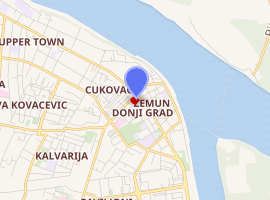Church of the Holy Virgin, Zemun
Church of the Nativity of the Virgin Mary, known as the Church of the Holy Virgin is a Serbian Orthodox Church church located on Rajačićeva Street in the center of Zemun, Serbia.
| Church of Holy Virgin in Zemun | |
|---|---|

| |
| General information | |
| Type | Cultural monument |
| Location | Zemun, Belgrade |
| Country | Serbia |
| Completed | 1774 |
History
The Treaty of Passarowitz, then the Treaty of Belgrade, suppressed the Turkish authorities from southeastern Syrmia Srem and Zemun found itself on the border of two empires:Аustria and Turkey. After several changes established military-civil administration was established, so that Zemun as part of Austria and its Military border became a free military community. Years of peace that followed allowed the rapid economic growth and development of the citizens, merchants and craftsmen. The progress of the border city was reflected in the increase in population, the construction of public and private houses and expanding settlements which were inhabited by Serbs, Germans, Јews, Greeks, Aromanians and other nations. The cornerstone for a new Orthodox church was laid in the summer of 1776 at the western part of the old core of Zemun[1] developed from the beginning of the eighteenth century, whose construction was financed by residents of Zemun of Serbian, Greek and Aromanian nationality. The church was completed in 1780. The church was completed in 1780.
Description
The church is a one-nave late Baroque building with a semicircular apse and shallow choirs, which received a high bell tower on the west side in the late eighteenth century which was only slightly lower than the tower of the nearby church of the Blessed Virgin Mary. The first bell, which was set up in 1815, illustrated the victory over Napoleon. Later, with the exception of that bell, which still exists, two more bells were set up. A rare depository designed for the disposal of the remains is buried beneath the bell tower, which was not used for that purpose, and was designed according to the rules, which are still respected primarily in the monasteries of the Greek orthodox church.[2] Sources state that the "new" church, as it was called in the people, served the religious needs of Greeks, Aromanians and Serbs who share the same religion, who gave contributions for its maintenance. The ceremonies were conducted in Church Slavonic, and on certain days (until 1914) in Greek as well. The temple with the entrance became the center of the organized church, educational and cultural activities of Zemun Serbs during the 19th century. The church was significantly rebuilt in 1890, 1937 and 1999, and in 2009, it received decorative lighting. The liturgy in the church was repeatedly served by patriarchs of the Serbian Orthodox Church.[3][4][5]
Architecture
The Church of Holy Virgin[6] is the largest church in the old part of Zemun, with one nave, shallow choir areas and a slender two-storey bell tower which rises from the west facade. It has a richly carved baroque iconostasis which was carved by the woodcutter Aksentije Marković, with icons by the renowned and prolific iconographer and classical painter, Arsenije Teodorović.[7] The bell and iconostasis were set during the same year. Teodorović painted the murals on the first vault below the iconostasis and on the first arc in front of the altar. The kathedra was painted with a depiction of Sveti Sava reconciling his brothers over his father's grave.
The church has a rich treasury, library and archive, which includes the 1782 Gospel of Moscow with illustrations from the year 1788 by Hadži Ruvim, Archimandrite of Monastery Bogovađa and Monastery Voljavče.
The church was restored from 2000 to 2001, during which the murals were restored and a new floor was installed with a heating system beneath. The church is combined with the Home of the Serbian Church Municipality, with which it shares the same lot.
Gallery
- The front facade with a bell tower (1880)
- Mosaic on the front facade of the church
- Lateral facade of the church
- Mosaic on the lateral facade of the church
- Upgraded part of the church with a bell tower and depositarium
- Belfry by night
References
- Жељко Шкаламера, Старо језгро Земуна, св. 7, ЗЗСКГБ, Београд, 1967, 72.
- Миодраг Јовановић, Српско црквено градитељство и сликарство новијег доба, Крагујевац, 1987, 72.
- „Данас“ – „Данас је Мала Госпојина“, 21.9.2005.
- Б92 – „Православни верници славе Божић“, 7.1.2007.
- Српска православна црква – „230 година Богородичине цркве у Земуну“, 22.9.2010.
- Миодраг Дабижић, Гласник, Службени лист СПЦ, бр. 10, Београд, 1980.
- Лепосава Шелмић, Олга Микић, дело Арсенија Теодоровића, Нови Сад, 1972, 22.
- Zemun Municipality – Church of Holy Virgin
- П. Марковић – „Земун од најстарији времена па до данас“, 1896; репринт. 2004.
ISBN 86-84149-08-4.
- Бранко Најхолд, Земунске цркве, ТРАГ, Земун, 1993.,
External links
- Official network place
- Old official network place
- Church of Holy Virgin 360 virtual tour
- The official website of the Municipality of Zemun: Religion and religious communities
- Belgrade Heritage: Church of Holy Virgin
- Belgrade City Institute for the Protection of Cultural Monuments/Immovable cultural property base